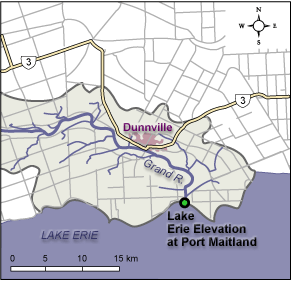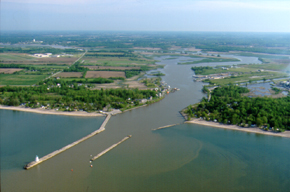Lake Erie Level
- Learn how to read these charts on our River and stream flows page.
- Many timeseries can be downloaded from our Data Downloads page.
Lake Erie Data
The above chart displays data collected from Ministry of Natural Resources and Forestry (MNRF) and GRCA gauges that monitor Lake Erie. Data on the chart is updated every 10 minutes. The chart also identifies five Lake Erie Flood Warning Zones which affect properties in Haldimand County. Flood threshold elevations for the warning zones are: Zone 1 – 175.5m, Zone 2 - 175.75m, Zone 3 – 176.0m, Zone 4 – 176.25m, Zone 5 – 176.5m.
If you are a Haldimand County resident or business and want to find out if your property is affected, visit www.haldimandcounty.ca/floods to map your property and learn more about who you should contact in the event of Lake Erie flooding.
Lake Erie Forecast
Also included on the Lake Erie chart above is a provisional lake surge model forecast provided courtesy of the MNRF. This forecast is updated twice daily at 1:00 a.m. and 1:00 p.m. and provides a 48-hour forecast outlook of potential lake surge events.
Lake Erie Levels
Lake Erie levels are naturally impacted by many factors including wind, precipitation, and ice cover. Normal fluctuations in lake levels can happen both seasonally and longer-term. Unlike the lower St. Lawrence and Lake Ontario, Lake Erie is unregulated and human influences on water levels are negligible.
Lake Erie static levels typically peak in May/June each year due to spring runoff which causes the level of theGreat Lakes to rise.
Weather systems can cause water to surge on Lake Erie resulting in water levels increasing above the normal (static) level. There is a higher risk of seasonal lake surge events between November and April. Waves associated with these surge events can further increase water levels.
More Information
- Port Colborne gauge – Department of Fisheries and Oceans
- Port Dover gauge – Department of Fisheries and Oceans
- Great Lakes Water Levels and Related Data – Environment Canada
Location of Lake Erie Gauge


Provisional Data
Caution: Users of the GRCA's real-time data are cautioned to consider the provisional nature of the information before using it for decisions that concern personal or public safety or the conduct of business.
The Grand River Conservation Authority assumes no responsibility for the correctness of the information contained in this website nor liability to any user of such information, regardless of the purpose.
Warning! River levels and flows can change rapidly.
Contact Us
Grand River Conservation Authority
400 Clyde Road, PO Box 729
Cambridge, ON
N1R 5W6
Phone: 519-621-2761
Toll Free: 1-866-900-4722
grca@grandriver.ca
